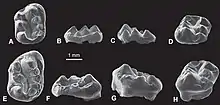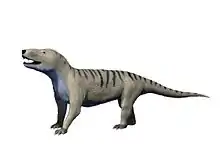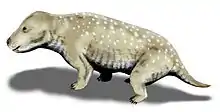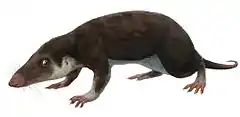Thomasia (animal)
Thomasia is a mammaliaform from the family Haramiyidae that is part of a lineage either unrelated to or a paraphyletic parent to multituberculates[1] from the Early Jurassic period.
| Thomasia | |
|---|---|
 | |
| Molariforms of Thomasia cf. moorei | |
| Scientific classification | |
| Kingdom: | Animalia |
| Phylum: | Chordata |
| Clade: | Therapsida |
| Clade: | Cynodontia |
| Order: | †Haramiyida |
| Family: | †Haramiyidae |
| Genus: | †Thomasia Poche, 1908 |
| Type species | |
| †Microlestes antiquus Pleininger, 1847 | |
| Species | |
| |
| Synonyms | |
| |
Only its teeth and skull have been found; judging from these it has been constructed as a 12 cm (5 in) creature with a resemblance to modern voles. It is presumed to have fed on the leaves of tree ferns, as it had broad cheek teeth for crushing tough vegetable food.[2][3]
Distribution
Fossils of the genus have been found in:[4]
- Triassic
- Sables and Grès de Mortinsart Formations, Gaume, Belgium
- Microlestes Quarry, Frome, England
- Exter and Trossingen Formations, Germany
- Auf dem Heftgen, Syren, Luxembourg
- Klettgau Formation, Switzerland
- Gres à Avicula contorta Formation, Franche-Comté and Lorraine, France
- Jurassic
- Pant Fissure System 4, Pant Quarry, St. Bride's Island, Wales
References
- http://palaeos.com/vertebrates/mammaliformes/mammaliformes.html#Haramiyida Palaeos on Haramiya
- Palmer, D., ed. (1999). The Marshall Illustrated Encyclopedia of Dinosaurs and Prehistoric Animals. London: Marshall Editions. p. 199. ISBN 1-84028-152-9.
- Zofia Kielan-Jaworowska, Richard L. Cifelli, and Zhe-Xi Luo, Mammals from the Age of Dinosaurs: Origins, Evolution, and Structure (New York: Columbia University Press, 2004), 249–260.
- Thomasia at Fossilworks.org
This article is issued from Wikipedia. The text is licensed under Creative Commons - Attribution - Sharealike. Additional terms may apply for the media files.







